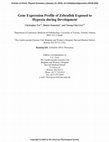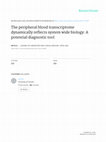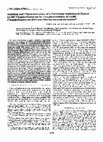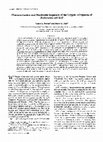Papers by Choong-chin Liew

Physiological genomics, Jan 16, 2003
Understanding how vertebrates respond to hypoxia can have important clinical implications. Fish h... more Understanding how vertebrates respond to hypoxia can have important clinical implications. Fish have evolved the ability to survive long exposure to low oxygen levels. However, little is known about the specific changes in gene expression that result from hypoxia. In this study we used a zebrafish cDNA microarray to examine the expression of >4,500 genes in zebrafish embryos exposed to 24 h of hypoxia during development. We tested the hypotheses that hypoxia changes gene expression profile of the zebrafish embryos and that these changes can be reverted by reexposure to a normoxic (20.8% O(2)) environment. Our data were consistent with both of these hypotheses: indicating that zebrafish embryos undergo adaptive changes in gene expression in response to hypoxia. Our study provides a striking genetic portrait of the zebrafish embryos' adaptive responses to hypoxic stress and demonstrates the utility of the microarray technology as a tool for analyzing complex developmental proce...
from stem cells, promises to translate into improved Hematopoiesis is regulated by a complex gene... more from stem cells, promises to translate into improved Hematopoiesis is regulated by a complex gene extransplant therapies for the treatment of acquired and pression program. To gain further insight into the genetic disorders of the hematopoietic system (Dunbar, molecular mechanisms underlying this process in . Although a number of transcriphumans, we sampled the transcriptional activity of tion factor genes have been demonstrated to be necesthe CD34 / hematopoietic progenitor line KG1a by sary for the differentiation of lineage-restricted progensingle-pass sequencing the 5 ends of 1018 clones itor cells (Shivdasani and Orkin, 1996), the mechafrom a unidirectional cDNA library. Searches of pubnisms regulating stem cell lineage commitment remain lic databases with the resulting expressed sequence largely unknown (Ogawa, 1993).

Oncogene, Jan 12, 2004
To identify genes that are differentially expressed in human esophageal squamous cell carcinoma (... more To identify genes that are differentially expressed in human esophageal squamous cell carcinoma (ESCC), we have developed a cDNA microarray representing 34 176 clones to analyse gene expression profiles in ESCC. A total of 77 genes (including 31 novel genes) were downregulated, and 15 genes (including one novel gene) were upregulated in cancer tissues compared with their normal counterparts. Immunohistochemistry and Northern blot analysis were carried out to verify the cDNA microarray results. It was revealed that genes involved in squamous cell differentiation were coordinately downregulated, including annexin I, small proline-rich proteins (SPRRs), calcium-binding S100 proteins (S100A8, S100A9), transglutaminase (TGM3), cytokeratins (KRT4, KRT13), gut-enriched Krupple-like factor (GKLF) and cystatin A. Interestingly, most of the downregulated genes encoded Ca(2+)-binding or -modulating proteins that constitute the cell envelope (CE). Moreover, genes associated with invasion or pro...

Journal of Laboratory and Clinical Medicine, 2006
In our genome-wide survey of gene expression in human peripheral blood cells using both an expres... more In our genome-wide survey of gene expression in human peripheral blood cells using both an expressed sequence tag (EST) and a microarray hybridization approach, we identified the expression of a large proportion (approximately 80%) of the genes encoded in the human genome. Comparison of the peripheral blood transcriptome with genes expressed in nine different human tissue types revealed that expression of over 80% was shared with any given tissue. We also sought to determine whether those gene transcripts undetected by these methods were also expressed in peripheral blood cells. Using reverse-transcriptase-polymerase chain reaction, we detected additional tissue-specific gene transcripts including betamyosin heavy chain (heart specific) and insulin (specific to pancreatic islet beta cells), in circulating blood cells. Arguably, the detection of low levels of tissuespecific transcripts could be considered products of "illegitimate" transcription; however, our study also demonstrates that environmental conditions affect the transcriptional regulation of insulin in the peripheral blood. We thus hypothesize that blood cells can act as sentinels of disease and that we could capitalize on this property of blood for the diagnosis/prognosis of disease (the "Sentinel Principle"). Peripheral blood is an ideal surrogate tissue as it is readily obtainable, provides a large biosensor pool in the form of gene transcripts, and response to changes in the macro-and micro-environments is detectable as alterations in the levels of these gene transcripts. (J Lab Clin Med 2006;147:126 -132) Abbreviations: EST ϭ expressed sequence tag; IRB ϭ Independent Review Board; RT-PCR ϭ reverse-transcriptase-polymerase chain reaction
Somatic Cell and Molecular Genetics, 1996
As part of an endeavour to identify and characterize zinc finger genes of the cardiovascular syst... more As part of an endeavour to identify and characterize zinc finger genes of the cardiovascular system, a novel zinc finger gene, HHZ105, was isolated from a human fetal heart cDNA library. This gene was mapped by fluorescence in situ hybridization to human chromosome 7q22, a region associated with a number of genetic disorders and developmental deficiencies.
Somatic Cell and Molecular Genetics, 1996
An oligonucleotide probe for the consensus sequence of the linker region of zinc finger proteins ... more An oligonucleotide probe for the consensus sequence of the linker region of zinc finger proteins was used to isolate cDNA clones from a human fetal heart cDNA library. Following DNA sequencing analysis and comparison, genes for the novel clones were mapped by fluorescence in situ hybridization. We report the chromosomal localization of three zinc finger-coding genes to the region of centromere on human chromosome 10p11.1q-11.2, indicating involvement in gene duplication and chromosome rearrangement during primate evolution.
Somatic Cell and Molecular Genetics, 1996
A group of zinc-binding cDNA clones from a human fetal heart library was isolated using an oligon... more A group of zinc-binding cDNA clones from a human fetal heart library was isolated using an oligonucleotide probe to the consensus sequence of the linker region of zinc finger proteins. Genes for novel clones were mapped by fluorescence in situ hybridization. In the process, we identified a previously unrecognized locus for two zinc finger-coding genes in human chromosome 19q13.1-q13.3 (ZNF180,ZNF181), where genomic rearrangements were shown to be accompanied by various developmental abnormalities, DNA repair deficiencies, and cellular malignancies.
Proceedings of the National Academy of Sciences, 1989
We have isolated and analyzed the structure of the genes coding for the ea and .3 forms of the hu... more We have isolated and analyzed the structure of the genes coding for the ea and .3 forms of the human cardiac myosin heavy chain (MYHC). Detailed analysis of four overlapping MYHC genomic clones shows that the a-MYHC and .3-MYHC genes constitute a total length of 51 kilobases and are tandemly linked. The (-MYHC-encoding gene, predominantly expressed in the normal human ventricle and also in slowtwitch skeletal muscle, is located 4.5 kilobases upstream of the a-MYHC-encoding gene, which is predominantly expressed in normal human atrium. We have determined the nucleotide
Nucleic Acids Research, 1990
Page 1. Nucleic Acids Research, Vol. 18, No. 12 3647 Complete sequence and organization of the hu... more Page 1. Nucleic Acids Research, Vol. 18, No. 12 3647 Complete sequence and organization of the human cardiac -myosin heavy chain gene Choong-Chin Liew*, Michael J.Sole, Keiko Yamauchi-Takihara, Barbra Kellam, Douglas ...

New England Journal of Medicine, 1998
Mutations in the gene for cardiac myosin-binding protein C account for approximately 15 percent o... more Mutations in the gene for cardiac myosin-binding protein C account for approximately 15 percent of cases of familial hypertrophic cardiomyopathy. The spectrum of disease-causing mutations and the associated clinical features of these gene defects are unknown. DNA sequences encoding cardiac myosin-binding protein C were determined in unrelated patients with familial hypertrophic cardiomyopathy. Mutations were found in 16 probands, who had 574 family members at risk of inheriting these defects. The genotypes of these family members were determined, and the clinical status of 212 family members with mutations in the gene for cardiac myosin-binding protein C was assessed. Twelve novel mutations were identified in probands from 16 families. Four were missense mutations; eight defects (insertions, deletions, and splice mutations) were predicted to truncate cardiac myosin-binding protein C. The clinical expression of either missense or truncation mutations was similar to that observed for other genetic causes of hypertrophic cardiomyopathy, but the age at onset of the disease differed markedly. Only 58 percent of adults under the age of 50 years who had a mutation in the cardiac myosin-binding protein C gene (68 of 117 patients) had cardiac hypertrophy; disease penetrance remained incomplete through the age of 60 years. Survival was generally better than that observed among patients with hypertrophic cardiomyopathy caused by other mutations in the genes for sarcomere proteins. Most deaths due to cardiac causes in these families occurred suddenly. The clinical expression of mutations in the gene for cardiac myosin-binding protein C is often delayed until middle age or old age. Delayed expression of cardiac hypertrophy and a favorable clinical course may hinder recognition of the heritable nature of mutations in the cardiac myosin-binding protein C gene. Clinical screening in adult life may be warranted for members of families characterized by hypertrophic cardiomyopathy.
Journal of the American College of Cardiology, 2002

Journal of Molecular Evolution, 1996
hnifU, a gene exhibiting similarity to nifU genes of nitrogen fixation gene clusters, was identif... more hnifU, a gene exhibiting similarity to nifU genes of nitrogen fixation gene clusters, was identified in the course of expressed sequence tag (EST) generation from a human fetal heart cDNA library. Northern blot of human tissues and polymerase chain reaction (PCR) using human genomic DNA verified that the hnifU gene represented a human gene rather than a microbial contaminant of the cDNA library. Conceptual translation of the hnifU cDNA yielded a protein product bearing 77% and 70% amino acid identity to NifU-like hypothetical proteins from Haemophilus influenzae and Saccharomyces cerevisiae, respectively, and 40-44% identity to the N-terminal regions of NifU proteins from several diazatrophs (i.e., nitrogen-fixing organisms). Pairwise determination of amino acid identities between the NifU-like proteins of nondiazatrophs showed that these NifU-like proteins exhibited higher sequence identity to each other (63-77%) than to the diazatrophic NifU proteins (40-48%). Further, the NifU-like proteins of non-nitrogen-fixing organisms were similar only to the N-terminal region of diazatrophic NifU proteins and therefore identified a novel modular domain in these NifU proteins. These findings support the hypothesis that NifU is indeed a modular protein. The high degree of sequence similarity between NifU-like proteins from species as divergent as humans and H. influenzae suggests that these proteins perform some basic cellular function and may be among the most highly conserved proteins.
Journal of Molecular Evolution, 1995
We have recently determined the complete nucleotide sequences of the cardiac c~-and B-myosin heav... more We have recently determined the complete nucleotide sequences of the cardiac c~-and B-myosin heavy chain (MyHC) genes from both human and Syrian hamster. These genomic sequence data were used to study the molecular evolution of the cardiac MyHC genes.

Journal of Molecular Biology, 1991
We have established a highly sensitive functional screen for the isolation of cDNAs encoding cAMP... more We have established a highly sensitive functional screen for the isolation of cDNAs encoding cAMP phosphodiesterases (PDEs) by complementation of defects in a Saccharomyces cereuisiae strain lacking both endogenous cAMP PDE genes, PDEl and PDE2. Three groups of cDNAs corresponding to three distinct human genes encoding CAMP-specific PDEs were isolated from a human glioblastoma cDNA library using this functional screen. Two of these genes are closely related to the Drosophila dunce CAMP-specific PDE. The third gene, which we named HCP1, encoded a novel CAMP-specific PDE. HCPl has an amino acid sequence related to the sequences of the catalytic domains of all cyclic nucleotide PDEs. HCPl is a high affinity CAMPspecific PDE (K, = 0.2 pM) that does not share other properties of the CAMP-specific PDE family, i.e. extensive sequence homology to the Drosophila dunce cAMP PDE and sensitivity to rolipram and R020-1724. The PDE activity of HCPl is not sensitive to cGMP or other inhibitors of the cGMP-inhibitable PDEs, such as milrinone. The biochemical and pharmacological properties of HCPl suggest that it is a member of a previously undiscovered cyclic nucleotide PDE family. Northern blot analysis indicates that high levels of HCP 1 mRNA are present in human skeletal muscle.

Journal of Molecular and Cellular Cardiology, 1994
In small mammals, the cardiac alpha-myosin heavy chain (MyHC) gene is predominantly expressed in ... more In small mammals, the cardiac alpha-myosin heavy chain (MyHC) gene is predominantly expressed in the adult ventricle, while the beta-MyHC gene is predominantly expressed in the fetal ventricle. In order to perform comparative studies of these genes, we sequenced the Syrian hamster alpha-MyHC gene by determining a continuous 32,415 base pair (bp) sequence. It contained 39 exons encoding a predicted polypeptide of 1939 amino acid residues (aa) with a molecular weight of 223,644 Da. Sequence comparison revealed that the coding sequence is highly identical to that of the human alpha-MyHC gene. A marked feature of the Syrian hamster alpha-MyHC gene was the abundance of reiterated sequences within introns. Eleven B1 and four B2 retroposons were identified, a variety of di-, tri-, and tetra-nucleotide repeats were present, and three longer direct repeats were found. Some of them appear to be associated with genetic recombination events.

Journal of Molecular and Cellular Cardiology, 1997
A. B C.-C. L. Telomerase Activity During Cardiac Development. Journal of Molecular an... more A. B C.-C. L. Telomerase Activity During Cardiac Development. Journal of Molecular and Cellular Cardiology (1997) 29, 2717-2724. Telomerase is a ribonucleoprotein involved in maintaining telomere length in stem cells and immortal and actively dividing cells. We report here for the first time that telomerase is developmentally regulated in the normal rat heart. When we compared rat hearts at different developmental stages, we found that telomerase activity decreased to 20% of the fetal level by 5 days after birth, and was undetectable by 20 days after birth. These results indicate that the rate of cardiomyocyte proliferation decreases dramatically soon after birth in the rat. Of several non-cardiac tissues examined, telomerase activity was highest in fetal and adult rat liver, suggesting that there is an active mechanism for maintaining long telomeres in liver tissue at all stages. The disappearance of telomerase activity in the rat heart at the time that cardiomyocytes become terminally differentiated suggests that telomerase downregulation is important in the permanent withdrawal of cardiomyocytes from the cell cycle.

Journal of Molecular and Cellular Cardiology, 2002
S. LEE. Adriamycin-induced Cardiomyocyte and Endothelial Cell Apoptosis: In Vitro and In Vivo Stu... more S. LEE. Adriamycin-induced Cardiomyocyte and Endothelial Cell Apoptosis: In Vitro and In Vivo Studies. Journal of Molecular and Cellular Cardiology (2002) 34, 1595±1607. Adriamycin is a potent, broad-spectrum chemotherapeutic agent effective against solid tumors and malignant hematological disease. The major limiting factor for adriamycin is its cardiotoxicity. Thus, the objective of this study was to investigate the role of cardiomyocyte and endothelial cell apoptosis in adriamycin-induced cardiomyopathy, in vivo and in vitro. For in vivo study, intraperitoneal injections of adriamycin were administered to nine adult male Wistar rats and normal saline to six rats as control. Eight of the nine rats in the adriamycin group, but none in the control group, developed marked ascites and DNA ladders in agarose gel electrophoresis of genomic DNA extracted from the rat hearts (P , 0.001). The ratio of apoptotic nuclei in the cardiomyocytes was signi®cantly higher for the adriamycin-treated rats (162 AE 149/10 6 cells) than for the controls (4.2 AE 1.3/10 6 cells; P , 0.01) by TUNEL assay. Increased endothelial cell apoptosis was detected in the small coronary vessels of the myocardium of the adriamycin-treated rats. Increased immuno-reactive Caspase-3 expression was also noted for both cardiomyocytes and endothelial cells of adriamycin-treated rats. In vitro adriamycin treatment for cultured neonatal rat cardiomyocytes and human umbilical vein endothelial cells, respectively, showed a dose-related increase in apoptosis as determined by¯owcytometry, DNA ladder analysis, TUNEL assay and/or electron-microscope examination. A dose-related increase in the expression of Fas antigen, Bax and Caspase-3, as well as a decrease in the expression of Bcl-2, were determined for the adriamycin-treated cardiomyocytes using Northern blot analysis, reverse transcriptase polymerase chain reaction (RT-PCR) and ribonuclease protection assay. RT-PCR also revealed increased Fas antigen expression, decreased Bcl-2 expression, and no change in Bax expression for the adriamycin-treated human umbilical vein cells. Further, pretreatment with broad caspase inhibitor, but not neutralizing FasL antibody, resulted in inhibition of adriamycin-induced endothelial cell apoptosis. In conclusion, these results indicate that both adriamycin-induced cardiomyocyte and endothelial cell death can occur via apoptosis which is dose-related, and can occur both in vitro and in vivo with changes in the expression of the apoptosis-related genes. Adriamycin-induced endothelial cell apoptosis is mediated by caspase activation but is Fas/FasL signal pathway independent. Our data provides evidence that both cardiomyocyte and endothelial cell apoptosis may play an important role in adriamycin-induced cardiomyopathy. #
Journal of Molecular and Cellular Cardiology, 1999

Journal of Molecular and Cellular Cardiology, 1996
A clone with high sequence homology to a rat muscle LIM protein has been isolated from a human fe... more A clone with high sequence homology to a rat muscle LIM protein has been isolated from a human fetal heart cDNA library. The isolated cDNA is 887 bp in length, with an open reading frame of 194 amino acid residues. Northern blot analysis revealed that it is predominantly expressed in fetal and neonatal hearts, with a low level of expression in adult heart and slow-twitch skeletal muscle (soleus). No detectable expression of this transcript was found in other tissues. Its cardiac expression and structural similarity to the rat homolog implied a regulatory role in human cardiac muscle. The biological property was confirmed by zinc binding assay, demonstrating its zinc-binding affinity. Homology of CLP to a rat muscle LIM protein and its predominantly differential expression in cardiac tissue imply its significant putative role in the development and growth of the human heart.

Uploads
Papers by Choong-chin Liew